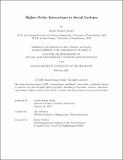Higher-Order Interactions in Social Systems
Author(s)
Sarker, Arnab Kumar
DownloadThesis PDF (5.862Mb)
Advisor
Jadbabaie, Ali
Terms of use
Metadata
Show full item recordAbstract
The de facto representation of a social network is a graph— individuals are represented as nodes, and relationships between pairs of individuals are represented as edges. This results in a powerful abstraction by which social relationships can be systematically studied to understand emergent population-scale behavior. However, many social interactions occur in groups: three individuals may co-author a paper, a team of employees may collaborate on a task, a single tweet may mention four users. Breaking such interactions into a collection of pairwise relationships can oversimplify the rich social contexts in which these individuals know one another. This thesis explores a different paradigm of social network analysis, namely, using "higher-order" network models such as hypergraphs and simplicial complexes which can explicitly encode co-present contexts between three or more individuals. The first two projects describe how higher-order interactions can differ from pairwise interactions in terms of micro-level content and macro-level structure, respectively. The latter two projects then develop an applied mathematical toolkit for the algebraic topological analysis of higher-order interactions in social networks.
Date issued
2025-02Department
Massachusetts Institute of Technology. Institute for Data, Systems, and SocietyPublisher
Massachusetts Institute of Technology